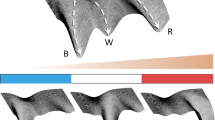Abstract
The robustness of patterning events in development is a key feature that must be accounted for in proposed models of these events. When considering explicitly cellular systems, robustness can be exhibited at different levels of organization. Consideration of two widespread patterning mechanisms suggests that robustness at the level of cell communities can result from variable development at the level of individual cells; models of these mechanisms show how interactions between participating cells guarantee community-level robustness. Cooperative interactions enhance homogeneity within communities of like cells and the sharpness of boundaries between communities of distinct cells, while competitive interactions amplify small inhomogeneities within communities of initially equivalent cells, resulting in fine-grained patterns of cell specialization.
Similar content being viewed by others
References
Collier, J. R., N. A. M. Monk, P. K. Maini and J. H. Lewis. 1996. Pattern formation by lateral inhibition with feedback: a mathematical model of Delta-Notch signalling.J. Theoret. Biol. 183, 429–446.
Cooke, J. 1995. Morphogens in vertebrate development: how do they work?Bioessays 17, 93–96.
Goodwin, B. C., S. Kauffman and J. D. Murray. 1993. Is morphogenesis an intrinsically robust process?J Theoret. Biol. 163, 135–144.
Green, J. B. A., H. V. New and J. C. Smith. 1992. Responses of embryonicXenopus cells to activin and FGF are separated by multiple dose thresholds and correspond to distinct axes of the mesoderm.Cell 71, 731–739.
Green, J. B. A. and J. C. Smith 1990. Graded changes in dose of aXenopus activin A homologue elicit stepwise transitions in embryonic cell fate.Nature 347, 391–394.
Green, J. B. A., J. C. Smith and J. C. Gerhart. 1994. Slow emergence of a multithreshold response to activin requires cell-contact-dependent sharpening but not prepattern.Development 120, 2271–2278.
Gurdon, J. B., P. Lemaire and K. Katc. 1993a. Community effects and related phenomena in development.Cell 75, 831–834.
Gurdon, J. B., E. Tiller, J. Roberts and K. Kato. 1993b. A community effect in muscle development.Curr. Biol. 3, 1–11.
Gurdon, J. B., P. Harger, A. Mitchell and P. Lemaire. 1994. Activin signalling and response to a morphogen gradient.Nature 371, 487–492.
Gurdon, J. B., A. Mitchell and D. Mahoney. 1995. Direct and continuous assessment by cells of their position in a morphogen gradient.Nature 376, 520–521.
Heitzler, P. and P. Simpson. 1991. The choice of cell fate in the epidermis ofDrosophila.Cell 64, 1083–1092.
Isaacs, H. V., M. E. Pownall and J. M. W. Slack. 1994. eFGF regulatesXbra expression duringXenopus gastrulation.EMBO J. 13, 4469–4481.
Kessler, D. S. and D. A. Melton 1994. Vertebrate embryonic induction: mesodermal and neural patterning.Science 266, 596–604.
Kroll, K. L. and E. Amaya. 1996. TransgenicXenopus embryos from sperm nuclear transplantations reveal FGF signaling requirements during gastrulation.Development 122, 3173–3183.
Lewis, J. 1996. Neurogenic genes and vertebrate neurogenesis.Curr. Opin. Neurobiol. 6, 3–10.
Monk, N. A. M. 1997. The community effect and ectoderm-mesoderm interaction inXenopus muscle differentiation.Bull. Math. Biol. 59, 409–425.
Muskavitch, M. A. T. 1994. Delta-Notch signaling andDrosophila cell fate choice.Dev. Biol. 166, 415–430.
Sachs, T. 1994. Variable development as a basis for robust pattern formation.J. Theoret. Biol. 170, 423–425.
Schnabel, R. 1996. Pattern formation: regional specification in the earlyC. elegans embryo.Bioessays 18, 591–594.
Schulte-Merker, S. and J. C. Smith 1995. Mesoderm formation in response toBrachyury requires FGF signalling.Curr. Biol. 5, 62–67.
Smith, J. C., V. Cunliffe, J. B. A. Green and H. V. New. 1993. Intercellular signalling in mesoderm formation during amphibian development.Proc. R. Soc. Lond. B 340, 287–296.
Sternberg, P. W. 1993. Falling off the knife edge.Curr. Biol. 3, 763–765.
Symes, K., C. Yordán and M. Mercola. 1994. Morphological differences inXenopus embryonic mesodermal cells are specified as an early response to distinct threshold concentrations of activin.Development 120, 2339–2346.
Wilson, P. A. and D. A. Melton. 1994. Mesodermal patterning by an inducer gradient depends on secondary cell-cell communication.Curr. Biol. 4, 676–686.
Wolpert, L. 1969. Positional information and the spatial pattern of cellular differentiation.J. Theoret. Biol. 25, 1–47.
Wolpert, L. 1996. One hundred years of positional information.Trends Genet. 12, 359–364.
Author information
Authors and Affiliations
Rights and permissions
About this article
Cite this article
Monk, N.A.M. Cell communities and robustness in development. Bltn Mathcal Biology 59, 1183–1189 (1997). https://doi.org/10.1007/BF02460107
Received:
Accepted:
Issue Date:
DOI: https://doi.org/10.1007/BF02460107




